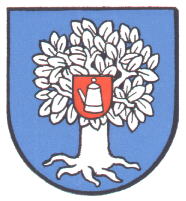Sillenbuch: Difference between revisions
Jump to navigation
Jump to search
Knorrepoes (talk | contribs) m (Text replacement - "50 pxCategory:Baden-Württemberg" to "Category:Baden-Württemberg") |
Knorrepoes (talk | contribs) m (Text replacement - "===Official blazon=== (de)" to "===Official blazon=== *(de)") |
||
| Line 9: | Line 9: | ||
===Official blazon=== | ===Official blazon=== | ||
(de) | *(de) | ||
===Origin/meaning=== | ===Origin/meaning=== | ||
The municipality of Sillenbuch was created in 1819, it was split from Rohracker. The new municipality did not use any arms or symbols on its seals. In 1913 the council applied for arms, and the State Archives proposed the above arms. The beech is canting (Buche), whereas the escutcheon shows the arms of [[Bad Cannstatt]], as the village belonged to the district Cannstatt of Württemberg. | The municipality of Sillenbuch was created in 1819, it was split from Rohracker. The new municipality did not use any arms or symbols on its seals. In 1913 the council applied for arms, and the State Archives proposed the above arms. The beech is canting (Buche), whereas the escutcheon shows the arms of [[Bad Cannstatt]], as the village belonged to the district Cannstatt of Württemberg. | ||
Revision as of 13:17, 9 February 2020
This page is part of the German heraldry portal Deutsche Wappensammlung |
Heraldry of the World |
|
German heraldry:
|
Selected collector's items from Germany:
|
SILLENBUCH
State : Baden-Württemberg
District (Kreis) : Stuttgart
Incorporated into : 1937 Stuttgart
Official blazon
- (de)
Origin/meaning
The municipality of Sillenbuch was created in 1819, it was split from Rohracker. The new municipality did not use any arms or symbols on its seals. In 1913 the council applied for arms, and the State Archives proposed the above arms. The beech is canting (Buche), whereas the escutcheon shows the arms of Bad Cannstatt, as the village belonged to the district Cannstatt of Württemberg.
Contact and Support
Partners:
Your logo here ?
Contact us
© since 1995, Heraldry of the World, Ralf Hartemink 
Index of the site
Literature : Bardua, 1973.












